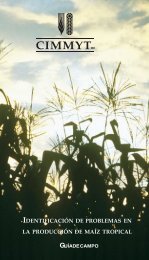Wheat Diseases and Pests - Wheat Doctor - CIMMYT
Wheat Diseases and Pests - Wheat Doctor - CIMMYT
Wheat Diseases and Pests - Wheat Doctor - CIMMYT
Create successful ePaper yourself
Turn your PDF publications into a flip-book with our unique Google optimized e-Paper software.
Alternaria Leaf Blight<br />
Alternaria triticina<br />
Symptoms: Small, chlorotic, oval- or elliptical-<br />
shaped lesions appear <strong>and</strong>, as they enlarge, these<br />
lesions become irregular in shape. The chlorotic<br />
borders of the lesions may become diffuse <strong>and</strong><br />
turn light to dark brown in color (24). Lesions are<br />
difficult to distinguish from those caused by<br />
Helrninthosporiurn spp. Infection usually starts on<br />
the lower leaves, but symptoms can be found on<br />
all plant parts.<br />
Development: The fungus survives as conidia on<br />
seed or as mycelia within seed. Sporulation on<br />
lower leaves provides inoculum that can be<br />
dispersed by wind, leading to secondary spread of<br />
the disease. Seed-borne inoculum often results in<br />
spike infections late in the crop cycle. High<br />
humidity or irrigation, as well as warmer<br />
temperatures (20' to 25'C) favor infection <strong>and</strong><br />
disease development.<br />
HostslDistribution: Bread wheat <strong>and</strong> durum wheat,<br />
as well as several related grasses, are the primary<br />
hosts. The disease is common in the eastern <strong>and</strong><br />
central areas of the Asian Subcontinent.<br />
Importance: Alternaria leaf blight can be very<br />
severe if environmental conditions are favorable<br />
for disease development; major losses can result<br />
when susceptible cultivars are grown.



